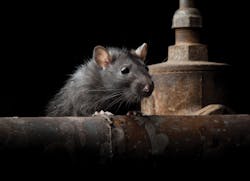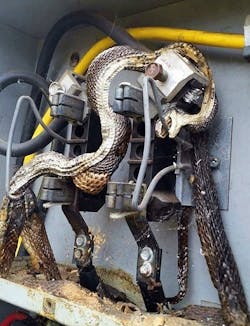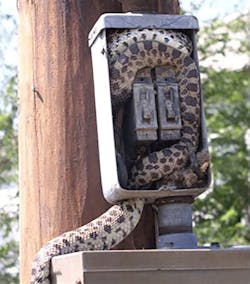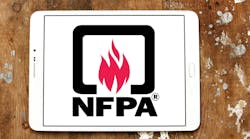By Robroy Enclosures
Most electrical workers with some experience know that pests can quickly infiltrate and destroy electrical components inside power and control enclosures. Rats, snakes, and small insects will take over a housing unit because it provides them with protection from the weather and predators. Damage from pests in an enclosure has been known to cause costly fires or total production shutdowns in many settings. What some electrical professionals might not know is failure of the panel could have been prevented with a little education on pest behavior and proper enclosure specification. Let’s look at some of the common behaviors of typical pests you may encounter in this line of work.
Rats and mice
According to a study conducted by Rentokil (available at https://www.rentokil.com/blog/rats-the-worlds-most-destructive-pest/#.WtOTHdPwZsM), 49% of businesses report electrical damage caused by pests. Rats are especially damaging because they chew on electrical wires (Photo 1): “Rats have a pair of continuously growing incisor teeth in both their upper and lower jaw. As a result, they have to continuously gnaw on objects to wear them down and prevent them from becoming too long.”
Based on information from Internet Center for Wildlife Damage Management (available at http://icwdm.org/handbook/rodents/RodentExclusion.asp), rats and mice can:
• Run along or climb electrical wires, pipes, fences, poles, ropes, cables, vines, shrubs, and trees to gain entry to a building.
• Climb almost any rough vertical surface, such as wood, brick, concrete, weathered sheet metal, and many plastic products.
• Crawl horizontally along or through pipes, augers, conveyors, conduit, underground utility, and communications lines.
• Gnaw through a wide variety of materials, including lead and aluminum sheeting, window screens, wood, rubber, vinyl, fiberglass, plastic, and low-quality concrete or concrete block.
Businesses in which food is stored or handled are especially prone to rodent invasion; therefore, stringent sanitation practices are essential.
Snakes
Like rats and mice, snakes often enter electrical boxes in search of food (Photo 2 and Photo 3). A snake’s climbing ability makes it easy for them to slither up and down electrical conduit. Once they enter the box, they are large enough to get shocked. Once shocked, all that will remain is the snake’s dead carcass and electrical controls that no longer operate. In 2017, a snake entered a substation and knocked out power for 22,000 customers in the Jacksonville, Fla., area.
Ants
According to Texas Cooperative Extension, College Station, Texas, electrical workers must be aware that ants will nest in enclosures. “What makes them especially dangerous is that they will defend their colony. These defense acts by ants can become a real physical threat to electrical personnel.” Ants also tend to build nests with soil, which will corrode components, thus causing control failure. Like rats, ants “will chew on wires and cause controls to fail.” Read more about managing fire ants in electrical enclosures at https://fireant.tamu.edu/files/2013/02/FAPFS011_2007rev.pdf.
Bees and wasps
Bees and wasps find small openings, which awards them easy entry into most electrical enclosures (Photo 4). The challenge is how to eliminate them without getting stung. According to the Michigan State University Extension Department of Plant, Soil and Microbial Sciences, killing off a wasp nest is tricky business. “As many of us know, the occupants of these nests tend to resist any effort to kill them by stinging the daylights out of those attempting to do so. During August, when the colony reaches its maximum size of worker wasps, the maximum size of the nest depends on the species. Paper wasps may only produce a few dozen workers while colonies of yellow jackets may reach one or two thousand. The larger nests of yellow jackets and bald-faced hornets that are protected by a papier-mâché type material are more challenging and best left to pest control professionals.”
Prevention
To prevent damage to electrical equipment, electrical professionals need to make sure the building, environment, and controls are secure. Pests are experts at finding even the smallest openings no matter if the controls are outside or inside.
Pests that find their way into a building’s structure will have access to all passageways for cables, pipes, and conduits that are integrated into the walls and ceilings, often making them hard to find and eliminate. By inspecting the building’s foundation, conduit, pipes, outlets, water spigots, gaps at the base of a door, and windows that are not caulked properly, you can prevent pests from entering.
Properly fill any openings with pest-proof materials such as concrete, galvanized sheet metal, wire mesh, aluminum, copper, stainless steel wool, and other materials.
Having clean hands during the installation is important, especially after eating, because food smells on the wiring will attract pest into the control housing. Keep all food items in secure containers and away from power and control devices.
Specification of the enclosure
While everyone is cost-conscious, choosing the least expensive electrical components, such as enclosures, is not always in your best interest. Select an enclosure designed to protect against intrusions. There are numerous enclosure options, such as materials, ratings, and hardware.
Process facility designers with the opportunity to select their material should investigate and determine the selections that are appropriate in the intended environment. Every application has unique demands, and many performance capabilities are inherent in certain material choices. However, an errant or overestimated material choice can have many repercussions in the life cycle of a product. It makes sense to select a product that is sufficient across the board.
Types of enclosures
Stainless steel and other premium metal materials can be used where long life, corrosion resistance, and weatherability are critical. Due to the higher cost of stainless steel enclosures compared to some other material options, it is important to consider the environment in which the stainless steel enclosures will be placed. Although stainless steel is corrosion-resistant, some environments (such as coastal saltwater areas or chlorine exposure) could still cause early failure of the enclosure. Lower grades of carbon steel can also corrode faster in harsh environments. Lastly, steel has high strength but exhibits low toughness, meaning it dents easily.
When it comes to nonmetallic enclosures, fiberglass and polycarbonate material options have several advantages. These options are easy to modify (simple to drill cutouts), are non-conductive, and withstand extreme cold/ heat. In addition, they are also cost effective.
Ratings
The National Electrical Manufacturers Association (NEMA) standards for enclosures indicate the amount of protection they are designed to provide. NEMA’s full standards can be found at https://www.nema.org/Products/Documents/nema-enclosure-types.pdf.
The seal of the NEMA 4X enclosure is designed to provide a degree of protection to the equipment inside the enclosure against ingress of solid foreign objects (windblown dust) and provides a degree of protection with respect to harmful effects on the equipment due to ingress of moisture (rain, sleet, snow, splashing water, and hose-directed water). Therefore, an enclosure with a well-designed sealing solution will prevent the intrusion of even the smallest pests.
Electrical enclosures are also often put into harm’s way in commercial and industrial environments — especially in environments such as warehouse or outdoor work areas where damage from collisions with heavy machinery, equipment, vehicles, and vandalism can be a daily occurrence.
The internationally recognized IK rating will help specifiers determine if the enclosure is rated to withstand impact in these environments, so they will not eventually make it easy for pest to enter the housing. IK ratings are defined as IKXX, where “XX” is a number from 00 to 10, indicating the degree of protection provided by electrical enclosures against external mechanical impact. The higher number indicates more protection, with an IK10 being the highest rating available.
Robroy Enclosures is a manufacturer of enclosures located headquartered in Belding, Mich. For more information, visit www.robroyenclosures.com.







